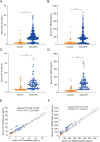Serum Cytokeratin 18 and Fragment as Biomarkers for Severity and Prognosis in Acute Exacerbation of Chronic Obstructive Pulmonary Disease
- PMID: 40789785
- PMCID: PMC12339617
- DOI: 10.1007/s00408-025-00841-3
Serum Cytokeratin 18 and Fragment as Biomarkers for Severity and Prognosis in Acute Exacerbation of Chronic Obstructive Pulmonary Disease
Abstract
Background: Cytokeratin (CK)18 is present in the bronchi and alveolar epithelium of the lung, and its cleavage product, CK-18M30, serves as a biological marker of apoptosis. However, the specific roles of CK-18 and CK-18M30 in acute exacerbation of chronic obstructive pulmonary disease (AECOPD) remain unclear.
Methods: This study enrolled 289 patients with AECOPD who met the inclusion criteria. Demographic information and clinical characteristics of the patients were documented. A 3-year follow-up period was implemented to evaluate acute exacerbations and mortality. Serum CK-18 and CK-18M30 concentrations were measured using enzyme-linked immunosorbent assays.
Results: Serum concentrations of CK-18/CK-18M30 at admission in patients with AECOPD were higher than those in the control group. As severity increased, serum CK-18/CK-18M30 levels increased progressively in AECOPD patients. Pearson's correlation analysis revealed that serum CK-18/CK-18M30 concentrations were positively correlated with several clinical parameters. Linear and logistic regression models demonstrated positive correlations between serum CK-18 and CK-18M30 levels at admission and severity scores. Furthermore, higher serum CK-18/CK-18M30 levels at admission were associated with increased frequency of death and acute exacerbation in patients with AECOPD within 3 years.
Conclusion: Serum CK-18/CK-18M30 levels at admission were positively correlated with severity and poor prognosis in patients with AECOPD within 3 years. Therefore, serum CK-18 and CK-18M30 concentrations may serve as novel diagnostic and prognostic biomarkers for patients with AECOPD.
Keywords: AECOPD; CK-18M30; Cohort study; Cytokeratin 18; Prognosis; Severity.
© 2025. The Author(s).
Conflict of interest statement
Declarations. Competing Interests: The authors declare no competing interests. Ethical Approval: This study was performed in compliance with the Declaration of Helsinki and was approved by the Ethics Committee of the Second Affiliated Hospital of Anhui Medical University (YX2021-146). Consent to Participate: Oral agreement or consent forms were obtained from patients or patients’ next of kin. Consent for Publication: Not applicable.
Figures



Similar articles
-
Associations of Serum Legumain with Severity and Prognosis Among Acute Exacerbation of Chronic Obstructive Pulmonary Disease Patients.Int J Chron Obstruct Pulmon Dis. 2025 Feb 25;20:437-447. doi: 10.2147/COPD.S507018. eCollection 2025. Int J Chron Obstruct Pulmon Dis. 2025. PMID: 40027200 Free PMC article.
-
The Clinical significance of Peripheral Blood-related Inflammatory Markers in patients with AECOPD.Immunobiology. 2025 May;230(3):152903. doi: 10.1016/j.imbio.2025.152903. Epub 2025 Apr 23. Immunobiology. 2025. PMID: 40286421
-
Self-management interventions including action plans for exacerbations versus usual care in patients with chronic obstructive pulmonary disease.Cochrane Database Syst Rev. 2017 Aug 4;8(8):CD011682. doi: 10.1002/14651858.CD011682.pub2. Cochrane Database Syst Rev. 2017. PMID: 28777450 Free PMC article.
-
Sputum colour charts to guide antibiotic self-treatment of acute exacerbation of chronic obstructive pulmonary disease: the Colour-COPD RCT.Health Technol Assess. 2025 May;29(28):1-42. doi: 10.3310/KPFD5558. Health Technol Assess. 2025. PMID: 40418146 Clinical Trial.
-
Non-invasive ventilation for the management of acute hypercapnic respiratory failure due to exacerbation of chronic obstructive pulmonary disease.Cochrane Database Syst Rev. 2017 Jul 13;7(7):CD004104. doi: 10.1002/14651858.CD004104.pub4. Cochrane Database Syst Rev. 2017. PMID: 28702957 Free PMC article.
References
-
- Christenson SA, Smith BM, Bafadhel M, Putcha N (2022) Chronic obstructive pulmonary disease. Lancet 399(10342):2227–2242. 10.1016/S0140-6736(22)00470-6 - PubMed
-
- Moll M, Silverman EK (2024) Precision approaches to chronic obstructive pulmonary disease management. Annu Rev Med 75:247–262. 10.1146/annurev-med-060622-101239 - PubMed
MeSH terms
Substances
Grants and funding
- 82270071/National Natural Science Foundation of China
- 82270071/National Natural Science Foundation of China
- 82270071/National Natural Science Foundation of China
- 82270071/National Natural Science Foundation of China
- 82270071/National Natural Science Foundation of China
- 82270071/National Natural Science Foundation of China
- 82270071/National Natural Science Foundation of China
- 2023AH030117/University Natural Science Research Project of Anhui Province
- 2023AH030117/University Natural Science Research Project of Anhui Province
- 2023AH030117/University Natural Science Research Project of Anhui Province
- 2023AH030117/University Natural Science Research Project of Anhui Province
- 2023AH030117/University Natural Science Research Project of Anhui Province
- 2023AH030117/University Natural Science Research Project of Anhui Province
- 2023AH030117/University Natural Science Research Project of Anhui Province
- AHWJ2021b091/Scientific Research of Health Commission in Anhui Province
- AHWJ2021b091/Scientific Research of Health Commission in Anhui Province
- AHWJ2021b091/Scientific Research of Health Commission in Anhui Province
- AHWJ2021b091/Scientific Research of Health Commission in Anhui Province
- AHWJ2021b091/Scientific Research of Health Commission in Anhui Province
- AHWJ2021b091/Scientific Research of Health Commission in Anhui Province
- AHWJ2021b091/Scientific Research of Health Commission in Anhui Province
- JKS2022007/Research Funds of the Center for Big Data and Population Health of IHM
- JKS2022007/Research Funds of the Center for Big Data and Population Health of IHM
- JKS2022007/Research Funds of the Center for Big Data and Population Health of IHM
- JKS2022007/Research Funds of the Center for Big Data and Population Health of IHM
- JKS2022007/Research Funds of the Center for Big Data and Population Health of IHM
- JKS2022007/Research Funds of the Center for Big Data and Population Health of IHM
- JKS2022007/Research Funds of the Center for Big Data and Population Health of IHM
- 202204295107020014/Anhui Provincial Clinical Research Transformation Project
- 202204295107020014/Anhui Provincial Clinical Research Transformation Project
- 202204295107020014/Anhui Provincial Clinical Research Transformation Project
- 202204295107020014/Anhui Provincial Clinical Research Transformation Project
- 202204295107020014/Anhui Provincial Clinical Research Transformation Project
- 202204295107020014/Anhui Provincial Clinical Research Transformation Project
- 202204295107020014/Anhui Provincial Clinical Research Transformation Project
- 2022AH040098/the University Natural Science Research Project of Anhui Province
- 2022AH040098/the University Natural Science Research Project of Anhui Province
- 2022AH040098/the University Natural Science Research Project of Anhui Province
- 2022AH040098/the University Natural Science Research Project of Anhui Province
- 2022AH040098/the University Natural Science Research Project of Anhui Province
- 2022AH040098/the University Natural Science Research Project of Anhui Province
- 2022AH040098/the University Natural Science Research Project of Anhui Province
LinkOut - more resources
Full Text Sources
Medical
Research Materials
Miscellaneous

